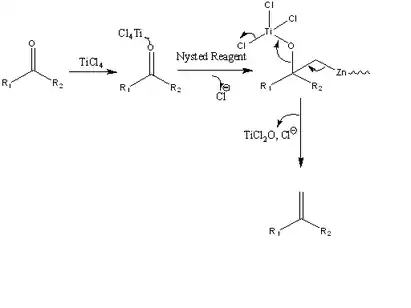 | |
| Names | |
|---|---|
| IUPAC name
cyclo-Dibromodi-μ-methylene[μ-(tetrahydrofuran)]trizinc | |
| Identifiers | |
3D model (JSmol) |
|
| ChemSpider | |
| |
| |
| Properties | |
| C6H12Br2OZn3 | |
| Molar mass | 456.14 g/mol |
| Hazards | |
| Occupational safety and health (OHS/OSH): | |
Main hazards |
Flammable, may form explosive peroxides and reacts violently with water |
| Flash point | −26.0 °C (−14.8 °F; 247.2 K) |
| Safety data sheet (SDS) | External MSDS |
Except where otherwise noted, data are given for materials in their standard state (at 25 °C [77 °F], 100 kPa).
Infobox references | |
The Nysted reagent is a reagent used in organic synthesis for the methylenation of a carbonyl group. It was discovered in 1975 by Leonard N. Nysted in Chicago, Illinois. It was originally prepared by reacting dibromomethane and activated zinc in THF.[1] A proposed mechanism for the methenylation reaction runs as follows:

A similar reagent is Tebbe's reagent.[2] In the Nysted olefination, the Nysted reagent reacts with TiCl4 to methylenate a carbonyl group. The biggest problem with these reagents are that the reactivity has not been well documented. It is believed that the TiCl4 acts as a mediator in the reaction. Nysted reagent can methylenate different carbonyl groups in the presence of different mediators. For example, in the presence of BF3•OEt2, the reagent will methylenate aldehydes. On the other hand, in the presence of TiCl4, TiCl3 or TiCl2 and BF3•OEt2, the reagent can methylenate ketones. Most commonly, it is used to methylenate ketones because of their general difficulty to methylenate due to crowding around the carbonyl group. The Nysted reagent is able to overcome the additional steric hindrance found in ketones, and more easily methylenate the carbonyl group. In contrast to the Wittig reaction the neutral reaction conditions of the Nysted reagent make it a useful alternative for the methylenation of easily enolizable ketones.
There is little research on Nysted reagent because of the hazards and high reactivity and the difficulty of keeping the reagent stable while it is in use. More specifically, it can form explosive peroxides when exposed to air and is extremely flammable. Also, it reacts violently with water. These make this reagent very dangerous to work with.[3][4][5][6][7]
See also
References
- ↑ Nysted, L.N. US Patent, 1975, 3 865 848. see Chem. Abstr., 1875, 83, 10406q.
- ↑ "Nysted Reagent." Comprehensive Organic Name Reactions and Reagents. 2010; John Wiley and Sons, Inc.
- ↑ "Nysted Reagent. MSDS No.381985". Sigma-Aldrich. April 3, 2009.
- ↑ Aïssa, Christophe; Riveiros, Ricardo; Ragot, Jacques; Fürstner, Alois (December 2003). "Total Syntheses of Amphidinolide T1, T3, T4, and T5". Journal of the American Chemical Society. 125 (50): 15512–15520. doi:10.1021/ja038216z. PMID 14664598.
- ↑ Paquette, Leo A.; Hartung, Ryan E.; Hofferberth, John E.; Vilotijevic, Ivan; Yang, Jiong (April 2004). "Synthesis of Stereoisomeric Medium-Ring α,α'-Dihydroxy Cycloalkanones". The Journal of Organic Chemistry. 69 (7): 2454–2460. doi:10.1021/jo0358675. PMID 15049645.
- ↑ Clark, J. Stephen; Fessard, Thomas C.; Wilson, Claire (May 2004). "A Concise and Stereoselective Synthesis of the A-Ring Fragment of the Gambieric Acids". Organic Letters. 6 (11): 1773–1776. doi:10.1021/ol049483s. PMID 15151411.
- ↑ Crich, David; Banerjee, Abhisek (June 2006). "Stereocontrolled Synthesis of the d - and l - glycero -β- d - manno -Heptopyranosides and Their 6-Deoxy Analogues. Synthesis of Methyl α- l - Rhamno -pyranosyl-(1→3)- d - glycero -β- d - manno -heptopyranosyl- (1→3)-6-deoxy- glycero -β- d - manno -heptopyranosyl-(1→4)-α- l - rhamno -pyranoside, a Tetrasaccharide Subunit of the Lipopolysaccharide from Plesimonas shigelloides". Journal of the American Chemical Society. 128 (24): 8078–8086. doi:10.1021/ja061594u. PMC 2617734. PMID 16771524.